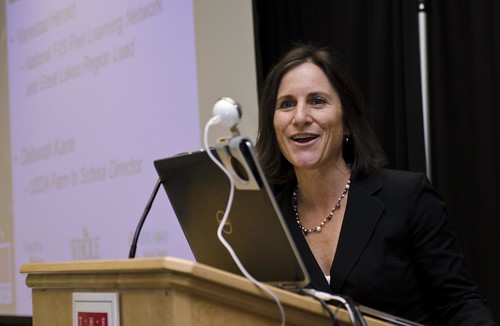
I was recently invited to give a presentation at the 2nd annual Ohio Farm to School Conference. Conference organizers asked me to address the future of farm to school: where did we want to be in ten years?
By chance I’d asked a similar question of colleagues at Portland Public Schools a decade earlier. At the time, we were just starting to incorporate more local and regional products into the cafeteria and we thought a creative writing exercise would help us crystallize our goals and focus our work.
In response to the prompt, “It’s ten years from now, you walk into the office, and….,” Kristy Obbink, then Portland’s school food service director, wrote:
“I am so excited about the order of fresh asparagus that will be delivered to the kitchen today. The farmer called yesterday to tell me he had plenty and he’d bring them this morning. The kids have been growing their own asparagus in the school garden, and are actually the ones that came up with the recipe we’ll be using in the cafeteria. The Federal Government made so much of this easier when they prioritized healthy eating for children in schools. It has made it possible for the kitchen and cafeteria to become valued as part of the educational day and we are less susceptible to budget cuts now that everyone understands how important a role we play in education.”
Me? I wrote, “It was such a thrill last night to watch Kristy receive that presidential Medal of Honor.”

Today the vision Kristy described of strong working relationships with local producers and engaged students is a reality for schools in Portland, Oregon and across the country. With the passage of the Healthy Hunger-Free Kids Act, federal standards are also now in place to further support all schools in their efforts to serve healthy meals. Medals of Honor are deserved by innumerable school food service professionals who have enthusiastically embraced changes in the school cafeteria -- Kristy and her team in Portland and the Ohioans who packed the recent conference among them.
At USDA, we’re pleased to support efforts to bring more local and regional food into the school cafeteria and very focused on providing schools with tools and resources to inspire their students to make healthy eating choices. In fact, our Farm to School Grant Program helps ensure more and more schools across the country can imagine a future where cafeterias are overflowing with local products and where children, with a keen understanding of where their food comes from, fill their plates with healthy, local fare.
Editor’s Note: FY 2014 USDA Farm to School Grant Applications are due April 24, 2013 midnight EST. For more information, please visit the Farm to School website. For information on other USDA efforts to support local and regional food systems, please see the Know Your Farmer Compass.
